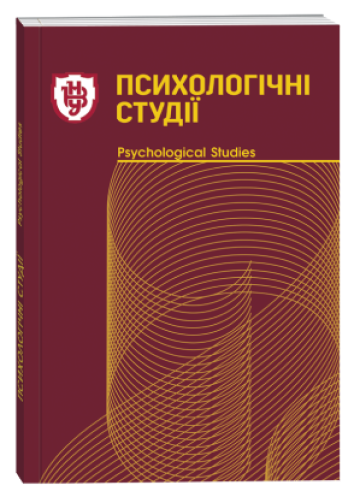IMAGINATIVE AND NARRATIVE MANIFESTATIONS OF THE SUBJECT’S LIMINALITY
DOI:
https://doi.org/10.32782/psych.studies/2023.2.13Keywords:
liminality, identification uncertainty, liminal state, subpersonalities, conscious self, disidentification, imagination, narrative, factual and counterfactual manifestations.Abstract
The article presents a theoretical analysis of the imaginative and narrative manifestations of subpersonalities in the structure of liminality of an adult subject based on the study of psychosynthesis as well as provides their classification. As a starting point in the study, the author considers the distinction between personal and subjective levels of liminality, in the development of which liminal states periodically arise. Awareness of these states is an identification uncertainty in which the subject of self-knowledge objectifies the protective and survival subpersonalities through imaginative and narrative forms of expression as an unreflected identification with them. A comparative analysis of the psychosynthesis concepts selected theoretical ideas of R. Assagioli, and current psychological research has shown that the imaginative and narrative manifestations of subpersonalities, as a result of disidentification by the conscious self, are objectified as integral objects that are realized in monologic or dialogic inner speech. It is emphasized that the experience of imaginations and narratives is a simultaneous process, the disidentification with which indicates the subjective level of the development of liminality. The author provides a rationale for dividing imaginative and narrative manifestations of liminality into factual and counterfactual or nostalgic-fantasy ones. Factual forms of liminality are divided into defensive (falsely positive by content) and survival (falsely negative). Counterfactual manifestations serve a compensatory function: they are an unconscious attempt to overcome the divergence between survival and protective manifestations, which leads to the narrowing of the time perspective of self-change or the so-called experience of “life on pause”. Within the framework of the problem of liminality's manifestations, the author identifies the issues of personality unchangeability, fear of the future, and existential anxiety as personal predictors of threshold self-knowledge at the stage of the liminal pause's completion.
References
Stein M. In Midlife. A Jungian Perspective. Texas : Spring Publications, 1993. 149 p.
Кучеренко Є. Ідентифікаційна невизначеність суб’єкта самопізнання в лімінальному стані. Психологія: реальність і перспективи. Випуск 20, 2023. С. 99–107. URL: https://doi. org/10.35619/praprv.v1i20.327
Land R., Meyer J. H. F., Flanagan M. T. (Eds.). Threshold Concepts in Practice. Rotterdam : SensePublishers, 2016. 362 p. URL: https://doi.org/10.1007/978-94-6300-512-8
De Pari M. Liminal Consciousness – A Systemic Framework for «Altered States of Consciousness». Proceedings of the 61st Annual Meeting of the ISSS – 2017 Vienna, Austria, 2017(1), 2019. URL: https://journals.isss.org/index.php/proceedings61st/article/view/3268
Кучеренко Є. В. Психосинтез: теорія і практика психотерапії : навчально-методичний посібник. Вінниця : ТОВ «ТВОРИ», 2018. 296 c.
Assagioli R. Psychosynthesis. A Manual of Principles and Techniques (A Collection of Basic Writings) (An Esalen Book). New York : Viking Compass Edition, 1974. 323 p.
Assagioli R. Subpersonalities. A collection of articles. In K. Sørenthen (Ed.). Kentaur Publishing, 2022. 124 p.
Dialogue with Assagioli, by Marta Crampton. 2018. URL: https://kennethsorensen.dk/en/ dialogue-with-assagioli
Notes Roberto Assagioli, by John Firman. 2020. URL: https://www.psychosynthesiscircle. com/notes
Fani C. L’Ovoide e il Sé. Rivista di autoformazione, educazione, rapporti interpersonali e sociali, terapia. Istituto di Psicosintesi fondato da Roberto Assagioli. 25, 2015. P. 17–18.
Firman J., Russell A. Opening to the inner child. Recovering authentic personality. Palo Alto : Psychosynthesis Palo Alto, 1994. 44 p.
Meriam C. Digging up the Past. Object Relations and Subpersonalities. Palo Alto : Psychosynthesis Palo Alto, 1994. 52 p.
Кучеренко Є.В. Особистісний досвід як проблема загальної психології та його субособистісна модель в психосинтезі. Загальна і медична психологія. НМУ імені О. Богомольця. 4(04), 2019. C. 3–8.
Кросс І. Внутрішній голос. Як навчитись слухати себе. Переклад з англ. О. Гладкого. Київ : Лабораторія, 2021. 192 c.
Елленгорн Е. Як ми змінюємося (& 10 причин, чому ми цього не робимо). Переклад з англ. І. Гоял. Київ : РІДНА МОВА, 2021. 320 c.
Наративні психотехнології / М. Смульсон, О. Шиловська, О. Гуцол ; за ред. Н. Чепелєвої. Київ : Главник, 2007. 162 c.
Ferrucci P. What We May Be: Techniques for Psychological and Spiritual Growth Through Psychosynthesis. London : Penguin Publishing Group, 2009. 384 p.
Brown M. Y. Growing Whole: Self-Realization for the Great Turning. Сalifornia : Psychosyntesis Press, 2009. 228 p.







